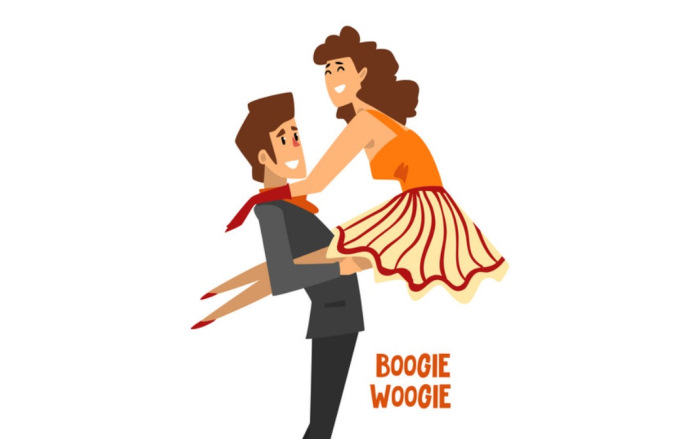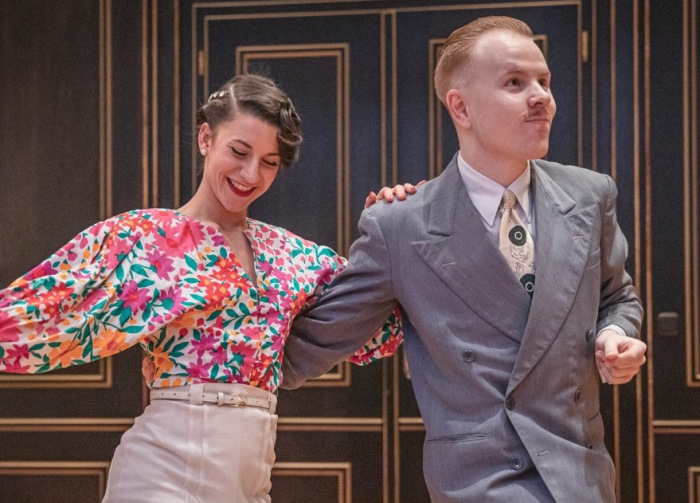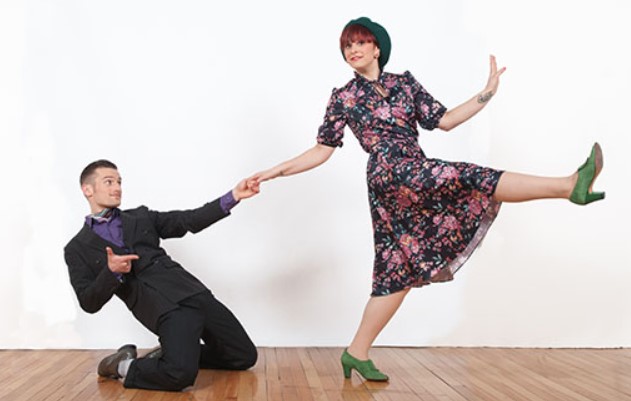The boogie-woogie dance is a classic dance style that has captivated audiences for nearly a century. Even today, its fast-paced, rhythmic beats and infectious energy haven’t gone out of vogue yet!
But who invented the boogie-woogie dance exactly? When and where did it start? How exactly did it capture the attention of not just club-goers in America but also many worldwide?
In this article, we’ll take a closer look at the origins and evolution of this iconic dance style, tracing its roots from its early beginnings to its modern-day popularity!
Ready? Let’s get to it!
Table of Contents
What Is Boogie Woogie Dance?
Boogie-woogie is a fast-paced, upbeat style of dance that originated in the United States. Although the dance style became popular in the 1950s, the boogie-woogie dance’s roots traced further back than that. There are records of the dance being created and performed in African-American communities all the way back in the 1870s!
It is characterized by its swing-like dance pattern (which is why many people consider it a variant of swing dancing). The dance style is often performed solo but can also be done with a partner.
There aren’t many records that show what the boogie-woogie dance meaning actually is. Many people think that it’s a combination of African terms, like “Boog” in Hausa, “Booga” in Mandingo (to beat), “Bogi” in West African (“to dance”), etc.
Boogie Woogie Dance Origin & History
Boogie-woogie dance has its roots in the blues and jazz music of the late 19th and early 20th centuries. In fact, the name for the dance was taken from a genre of music aptly called “Boogie-woogie” that was popular all the way through the 1940s.
During this rising era of boogie-woogie music, many musicians pushed the genre and brought it to the public’s attention. Names like Albert Ammons, Pete Johnson, and Meade Lux Lewis were legendary in the community.
Besides performing boogie-woogie music in large concert halls and dance halls, their performances were often accompanied by exciting dance numbers.
The accompanying dance didn’t emerge until the 1950s. It took inspiration from the dances that are done in Rock’n’Roll music and shared many characteristics with the Lindy Hop dance. While it was an offshoot of these dances at first, over the years, boogie-woogie eventually developed its own style and branched off to become an independent dance.
By the 1950s, boogie-woogie had become a staple of the emerging rock and roll genre. If you were around during this period, you’ll find the dance being done by club-goers not just in America but in many European countries, too.
The popularity of boogie-woogie has faded a lot over the years, but it still hasn’t gone away just yet. Many dance halls and competitions are still hosting boogie-woogie performances. And, of course, thousands of people are still practicing this jazzy dance worldwide!
Did you know: Jitterbug Dance
Boogie Woogie Dance Steps
Because boogie-woogie is a social dance, it’s “designed” to be as simple and easy to learn as possible. You don’t need to take classes or spend several hours a week going through exercises before learning the basic moves.
Instead, we’re certain that you can master the basic movements in just a day or two at home!
The Basic Steps
As the name suggests, this is going to be the first step that you’re going to learn if you want to practice the boogie-woogie. It’s pretty simple!
Step 1: Stand in Place and Perform a Rock Step
The “rock step” is when you make a step back with your working foot (usually the right foot), then rock back into your standing position with two feet next to one another.
So, let’s say that your working foot is the right foot.
Make a step back with your right foot, then lift the back of your left foot a few inches off the ground (while still being in place).
Put your left foot down, then drag your right foot back next to your left foot.
Step 2: Triple Steps
The next step to learn is the triple steps. Basically, you’ll be taking three steps sideways while standing in place.
Begin by lifting and lowering your right foot, then your left foot, and finally your right foot once more. Perform this motion while staying in the same place.
With each step, your feet should only glide a few inches above the ground.
Step 3: Triple Step, But Reverse Your Feet
Perform the sequence above, but with the opposite foot. So, if you did the triple steps above with your right foot, then do it with your left foot this time.
Step 4: Second Rock Step
Perform the same rock step sequence as in step one. Do it with the same foot that you performed in the first step (i.e. if you did the first step with your right foot, then perform this step with your right foot.)
Step 5: Repeat!
And that’s the basic step.
Keep on practicing these four steps until you’re comfortable with them. Then, you can proceed to learn more advanced dance sequences and techniques to add more wow factor to your performance!
Get Used to the Syncopation
Boogie Woogie is danced on music with syncopated beats. For beginners and those who haven’t danced before, dancing to syncopated beats is a bit more difficult than dancing to regular beats.
So, take some time to listen to boogie-woogie dance songs and tap your feet to the rhythm. It’ll ensure that you can keep up with the beat.
Swinging
Got the basic steps down? The next thing to add to your routine is a swing.
Remember, the boogie-woogie is a kind of swing dance. You’ll be missing out on a big part of what makes it such a cool dance style without grooving a little bit.
Shift your weight from one foot to the other. Create a rocking motion to your body. It’ll lend a lot of personality and energy to your performance.
Add a Partner
Boogie Woogie is a solo dance, but in a pinch, it can turn into a partnered dance, too. You can add turns to your routine to make your paired performance more dynamic. Simply spin around as you dance, then return to the basic step.
Don’t Forget to Experiment!
There’s a degree of improvisation to the boogie-woogie (thanks to its jazz root). So, don’t be afraid to experiment with different moves and rhythms.
Unlike formal ballroom dances, you’re not constrained to a fixed choreography. Dancers are free to make their own interpretations and spins on the music.
Notable Boogie Woogie Dancers
Boogie-woogie was and is still a popular dance style in many places around the world. Over the decades, there have been many dancers who are famous for their boogie-woogie performances.
Want to read more about them or give their records a watch?
Here’s a list of names that you can look through!
Nils and Bianca
Nils Andrén (coming from Sweden) and Bianca Locatelli (Sweden/Italy) are one of the most famous swing dancers today.
According to their official biography, they’re “full-time swing dance teachers, performers, and choreographers”. And indeed, the couple maintains a YouTube channel with over 100,000 subscribers, where they upload records of their best performances for your viewing pleasure.
On their channel, other than records of many different styles of swing dancing, you’ll also find dozens of videos about their boogie-woogie routines, as well.
According to Nils and Bianca, they love swing dancing because it brings people together and spread joy … it’s far more than just a dance. And we agree! The raw energy and fun that they exude while they’re on the dance floor is the reason why we love the art of dancing.
Other than traveling and participating in performances and competitions around the world, Nils and Bianca also host many swing dancing workshops at festivals. Give them a visit if you ever got the opportunity!
William Mauvais and Maéva Truntzer
William Mauvais and Maéva Truntzer are two dancers from France. In an interview, they said that they met when they were 14 years old and have hit it off ever since. The couple is known for their exceptional talent in dancing, particularly, boogie-woogie dancing.
Over the past decade, they have been winning many swing dancing competitions left and right. And they also hold the boogie-woogie dance championships in many Lindy Hop competitions (Lindy Hop is a variant of swing dancing).
Their best video on boogie-woogie has garnered over 29 million views on YouTube. It’s a masterclass on how advanced swing/boogie-woogie dancing looks like!
Sondre Olsen-Bye and Tanya Georgiievska
On their website, Sondre and Tanya said that their partnership began during the SwingAout Festival in 2015. And without going into much details, they said that ever since then, they have been traveling and competing in many swing dancing competitions with one another.
And like all the other couples on this list, Sondre and Tanya have excellent synergy on the dance stage. With their steps and passion, they have won many honors, like the champions and vice champions titles of various world and regional dancing competitions.
Boogie Woogie Dance Music & Songs
Contrary to popular belief, boogie-woogie isn’t danced on top of boogie-woogie music alone. In the modern day, people have taken to dancing the boogie-woogie to rock music in general.
A good song for boogie-woogie will usually feature a strong, repetitive bass line and a swing-style rhythm. The beats will often be syncopated. Most of the songs will have the classic sound of the blues.
If you want to listen to a few good songs and recordings, here are the top boogie-woogie songs to listen to:
- “Roll ‘Em Pete” by Pete Johnson and Big Joe Turner
- “Pinetop’s Boogie Woogie” by Pinetop Smith
- “Boogie Woogie Stomp” by Albert Ammons
- “Rockin’ the Boogie” by Freddie Slack
- “Boogie Woogie Bugle Boy” by The Andrews Sisters
Boogie Woogie Dance Competitions
- The Open Swing Dance Champions
- International Swing Dance Championships
- World Rock and Roll Confederation
- Rock That Swing
- Swing Dance America
- World Swing Dance Council
FAQs
1. What is the difference between Lindy Hop and boogie-woogie?
Although both dances are considered variants of the swing dance, there are big differences between the two. Lindy Hop is characterized by its aerial moves, acrobatics, and playful, improvisational style. It’s what most people think of when the word “swing dancing” is mentioned.
Boogie-woogie, on the other hand, is a simpler social dance that is characterized by its easy, repetitive steps. Footwork and rhythm are the core of the boogie-woogie, with less emphasis on beautiful, exciting choreography.
There’s a big difference in the dance music, too. Lindy Hop is performed to swing music, while boogie-woogie is done to rock music.
2. Is boogie-woogie the same as jazz?
Boogie-woogie and jazz are related, but they’re two different things. The music has different sounds (complex harmonies and emphasis on improvisation) while boogie-woogie is known for having a strong bass line and simpler, syncopated rhythms.
3. What is the difference between boogie and boogie-woogie?
The boogie is a rhythm in blues music that’s used by musicians to strike up a boogie-woogie song.
4. What is the difference between boogie-woogie and swing?
Boogie-woogie is considered a type of swing dance. Particularly, it’s said that it shares many characteristics with West Coast swing.
Conclusion
The boogie-woogie, even though it’s been around for quite literally a century, endures to this day. You’ll find many couples dancing the boogie woogie dance in dance halls, festivals, and competitions everywhere.
Now that you’ve learned about its history and origin, we hope that you’ve come to appreciate this classic dance a lot more!
Got any questions for us? Drop it in the comment section down below and we’ll get back to you as soon as we can!




